Enhancing Student Learning Through Problem-Based Learning Essay
VerifiedAdded on 2022/10/15
|14
|3554
|12
Essay
AI Summary
This essay delves into the concept of Problem-Based Learning (PBL), defining and describing its core principles and methodologies. It examines the appropriateness of PBL for students in a science education context, emphasizing its ability to foster independence, collaboration, and critical thinking. The essay details how PBL can be effectively used to support student learning, particularly in understanding abstract scientific concepts, through hands-on activities and group work. Furthermore, it explores the application of PBL within a physics classroom, specifically focusing on electrostatics and the charging of an electroscope by induction. The essay also highlights how PBL enhances communication, problem-solving skills, and individual responsibility among learners. It concludes by discussing the role of the teacher as a facilitator, the importance of resource availability, and the use of improvisation to enhance learning outcomes. The essay also provides an overview of the context in which the assignment is based.
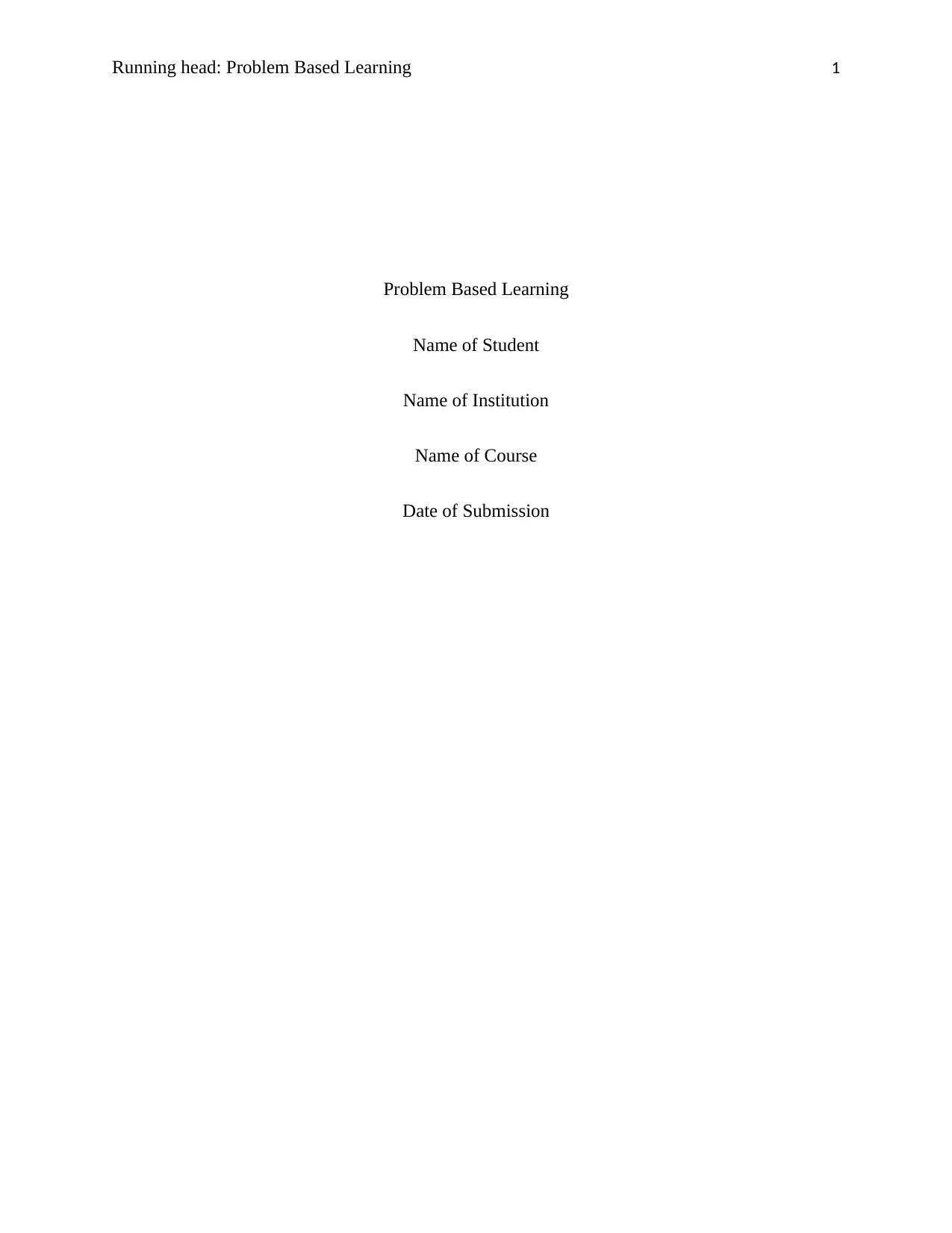
Running head: Problem Based Learning 1
Problem Based Learning
Name of Student
Name of Institution
Name of Course
Date of Submission
Problem Based Learning
Name of Student
Name of Institution
Name of Course
Date of Submission
Paraphrase This Document
Need a fresh take? Get an instant paraphrase of this document with our AI Paraphraser
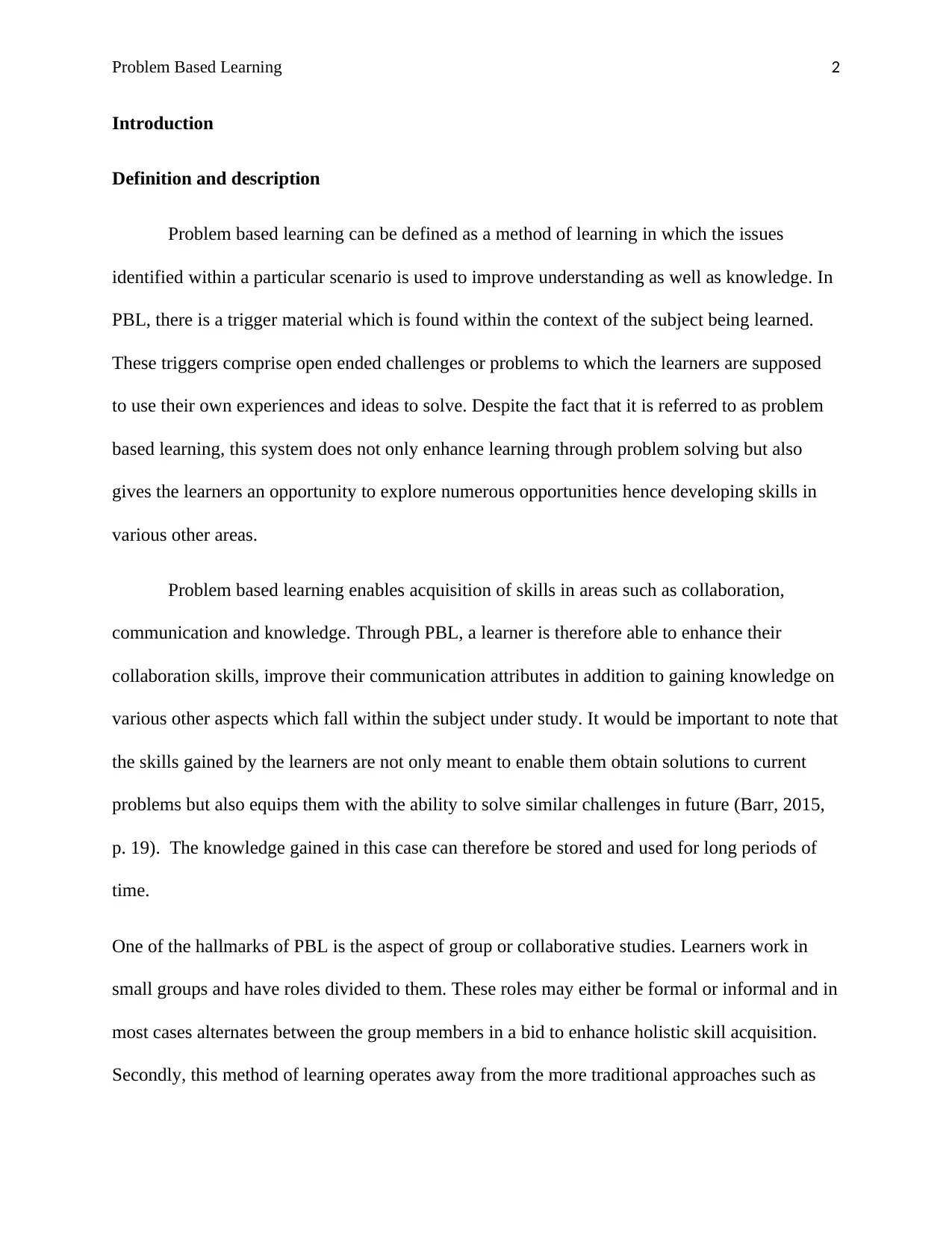
Problem Based Learning 2
Introduction
Definition and description
Problem based learning can be defined as a method of learning in which the issues
identified within a particular scenario is used to improve understanding as well as knowledge. In
PBL, there is a trigger material which is found within the context of the subject being learned.
These triggers comprise open ended challenges or problems to which the learners are supposed
to use their own experiences and ideas to solve. Despite the fact that it is referred to as problem
based learning, this system does not only enhance learning through problem solving but also
gives the learners an opportunity to explore numerous opportunities hence developing skills in
various other areas.
Problem based learning enables acquisition of skills in areas such as collaboration,
communication and knowledge. Through PBL, a learner is therefore able to enhance their
collaboration skills, improve their communication attributes in addition to gaining knowledge on
various other aspects which fall within the subject under study. It would be important to note that
the skills gained by the learners are not only meant to enable them obtain solutions to current
problems but also equips them with the ability to solve similar challenges in future (Barr, 2015,
p. 19). The knowledge gained in this case can therefore be stored and used for long periods of
time.
One of the hallmarks of PBL is the aspect of group or collaborative studies. Learners work in
small groups and have roles divided to them. These roles may either be formal or informal and in
most cases alternates between the group members in a bid to enhance holistic skill acquisition.
Secondly, this method of learning operates away from the more traditional approaches such as
Introduction
Definition and description
Problem based learning can be defined as a method of learning in which the issues
identified within a particular scenario is used to improve understanding as well as knowledge. In
PBL, there is a trigger material which is found within the context of the subject being learned.
These triggers comprise open ended challenges or problems to which the learners are supposed
to use their own experiences and ideas to solve. Despite the fact that it is referred to as problem
based learning, this system does not only enhance learning through problem solving but also
gives the learners an opportunity to explore numerous opportunities hence developing skills in
various other areas.
Problem based learning enables acquisition of skills in areas such as collaboration,
communication and knowledge. Through PBL, a learner is therefore able to enhance their
collaboration skills, improve their communication attributes in addition to gaining knowledge on
various other aspects which fall within the subject under study. It would be important to note that
the skills gained by the learners are not only meant to enable them obtain solutions to current
problems but also equips them with the ability to solve similar challenges in future (Barr, 2015,
p. 19). The knowledge gained in this case can therefore be stored and used for long periods of
time.
One of the hallmarks of PBL is the aspect of group or collaborative studies. Learners work in
small groups and have roles divided to them. These roles may either be formal or informal and in
most cases alternates between the group members in a bid to enhance holistic skill acquisition.
Secondly, this method of learning operates away from the more traditional approaches such as
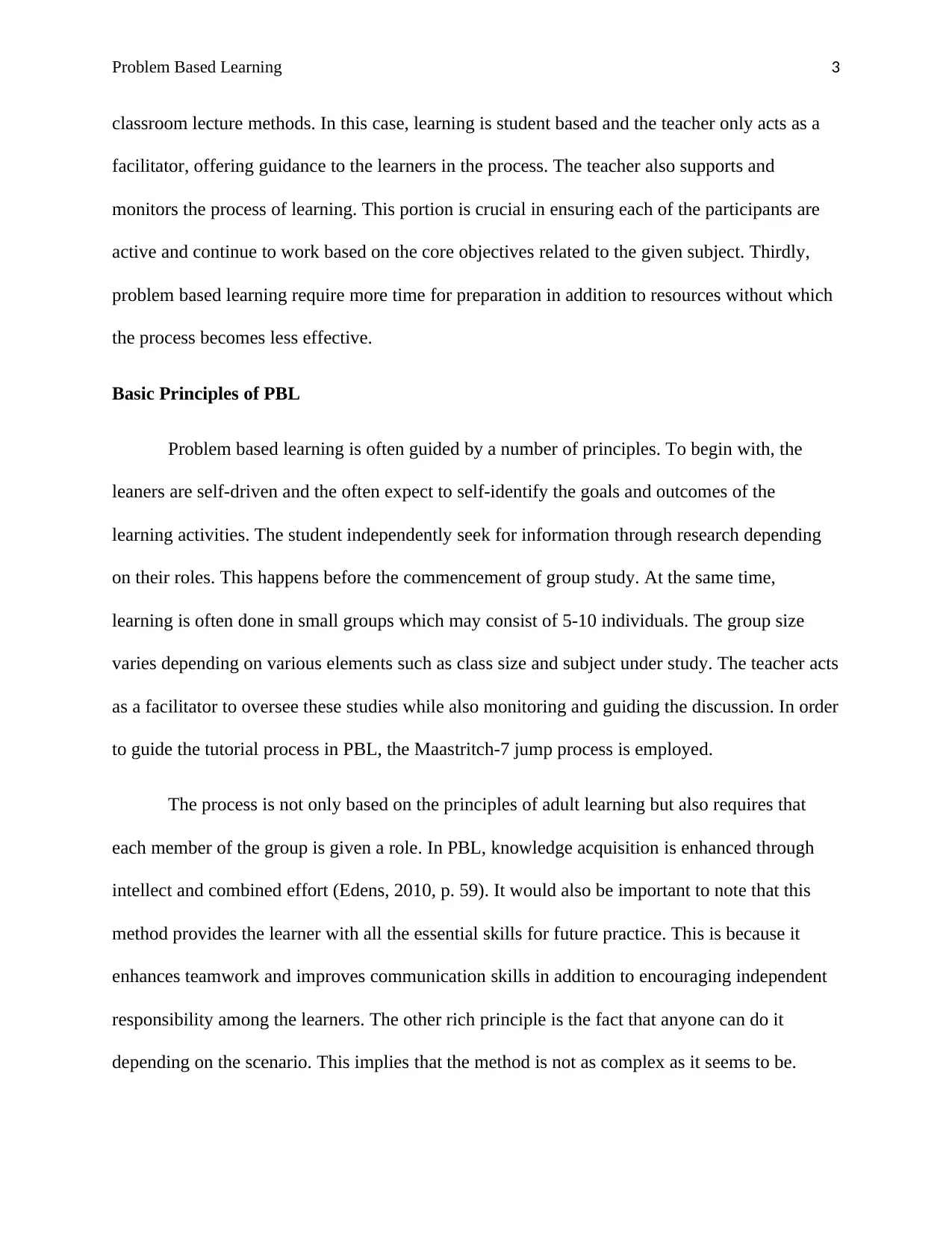
Problem Based Learning 3
classroom lecture methods. In this case, learning is student based and the teacher only acts as a
facilitator, offering guidance to the learners in the process. The teacher also supports and
monitors the process of learning. This portion is crucial in ensuring each of the participants are
active and continue to work based on the core objectives related to the given subject. Thirdly,
problem based learning require more time for preparation in addition to resources without which
the process becomes less effective.
Basic Principles of PBL
Problem based learning is often guided by a number of principles. To begin with, the
leaners are self-driven and the often expect to self-identify the goals and outcomes of the
learning activities. The student independently seek for information through research depending
on their roles. This happens before the commencement of group study. At the same time,
learning is often done in small groups which may consist of 5-10 individuals. The group size
varies depending on various elements such as class size and subject under study. The teacher acts
as a facilitator to oversee these studies while also monitoring and guiding the discussion. In order
to guide the tutorial process in PBL, the Maastritch-7 jump process is employed.
The process is not only based on the principles of adult learning but also requires that
each member of the group is given a role. In PBL, knowledge acquisition is enhanced through
intellect and combined effort (Edens, 2010, p. 59). It would also be important to note that this
method provides the learner with all the essential skills for future practice. This is because it
enhances teamwork and improves communication skills in addition to encouraging independent
responsibility among the learners. The other rich principle is the fact that anyone can do it
depending on the scenario. This implies that the method is not as complex as it seems to be.
classroom lecture methods. In this case, learning is student based and the teacher only acts as a
facilitator, offering guidance to the learners in the process. The teacher also supports and
monitors the process of learning. This portion is crucial in ensuring each of the participants are
active and continue to work based on the core objectives related to the given subject. Thirdly,
problem based learning require more time for preparation in addition to resources without which
the process becomes less effective.
Basic Principles of PBL
Problem based learning is often guided by a number of principles. To begin with, the
leaners are self-driven and the often expect to self-identify the goals and outcomes of the
learning activities. The student independently seek for information through research depending
on their roles. This happens before the commencement of group study. At the same time,
learning is often done in small groups which may consist of 5-10 individuals. The group size
varies depending on various elements such as class size and subject under study. The teacher acts
as a facilitator to oversee these studies while also monitoring and guiding the discussion. In order
to guide the tutorial process in PBL, the Maastritch-7 jump process is employed.
The process is not only based on the principles of adult learning but also requires that
each member of the group is given a role. In PBL, knowledge acquisition is enhanced through
intellect and combined effort (Edens, 2010, p. 59). It would also be important to note that this
method provides the learner with all the essential skills for future practice. This is because it
enhances teamwork and improves communication skills in addition to encouraging independent
responsibility among the learners. The other rich principle is the fact that anyone can do it
depending on the scenario. This implies that the method is not as complex as it seems to be.
⊘ This is a preview!⊘
Do you want full access?
Subscribe today to unlock all pages.

Trusted by 1+ million students worldwide
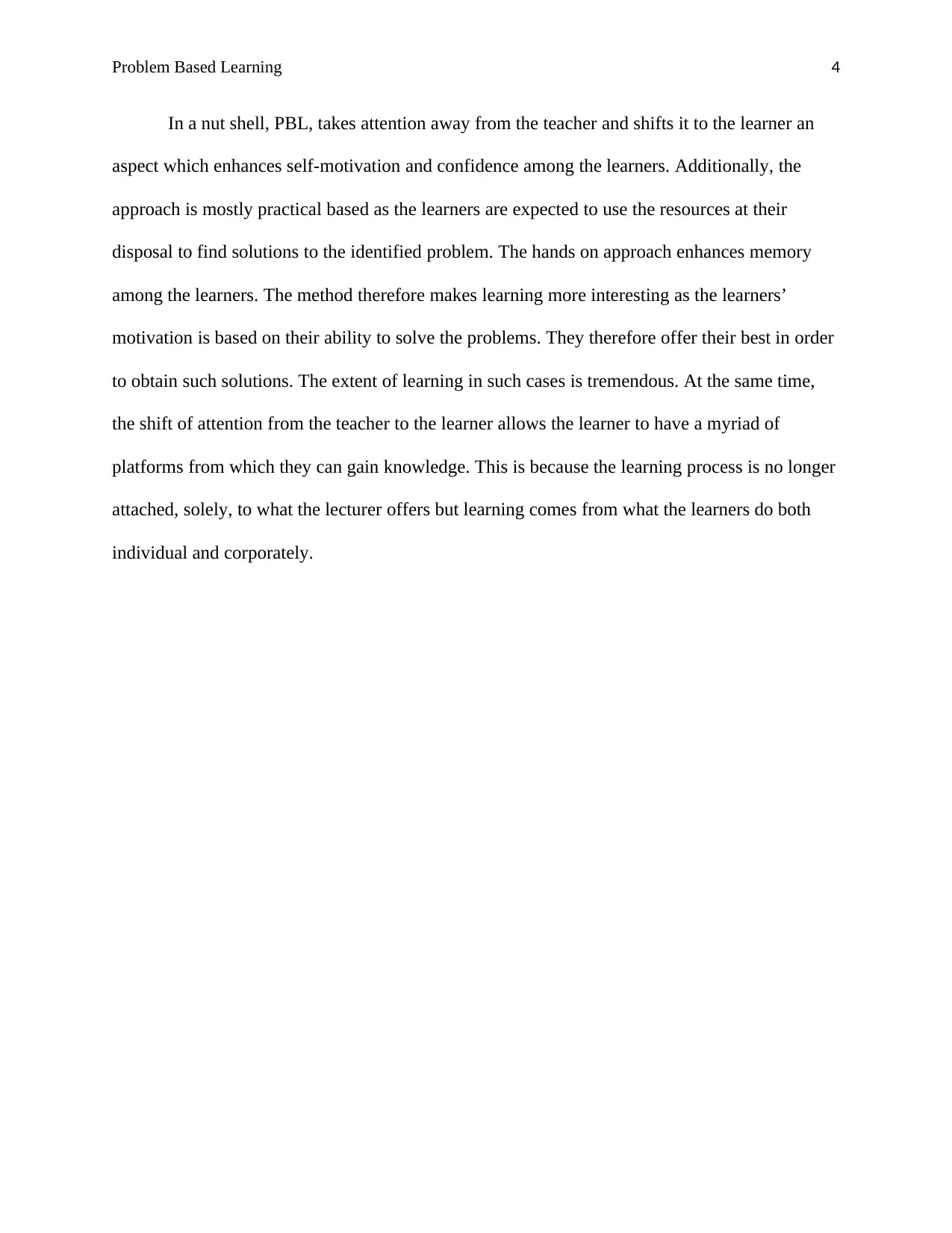
Problem Based Learning 4
In a nut shell, PBL, takes attention away from the teacher and shifts it to the learner an
aspect which enhances self-motivation and confidence among the learners. Additionally, the
approach is mostly practical based as the learners are expected to use the resources at their
disposal to find solutions to the identified problem. The hands on approach enhances memory
among the learners. The method therefore makes learning more interesting as the learners’
motivation is based on their ability to solve the problems. They therefore offer their best in order
to obtain such solutions. The extent of learning in such cases is tremendous. At the same time,
the shift of attention from the teacher to the learner allows the learner to have a myriad of
platforms from which they can gain knowledge. This is because the learning process is no longer
attached, solely, to what the lecturer offers but learning comes from what the learners do both
individual and corporately.
In a nut shell, PBL, takes attention away from the teacher and shifts it to the learner an
aspect which enhances self-motivation and confidence among the learners. Additionally, the
approach is mostly practical based as the learners are expected to use the resources at their
disposal to find solutions to the identified problem. The hands on approach enhances memory
among the learners. The method therefore makes learning more interesting as the learners’
motivation is based on their ability to solve the problems. They therefore offer their best in order
to obtain such solutions. The extent of learning in such cases is tremendous. At the same time,
the shift of attention from the teacher to the learner allows the learner to have a myriad of
platforms from which they can gain knowledge. This is because the learning process is no longer
attached, solely, to what the lecturer offers but learning comes from what the learners do both
individual and corporately.
Paraphrase This Document
Need a fresh take? Get an instant paraphrase of this document with our AI Paraphraser
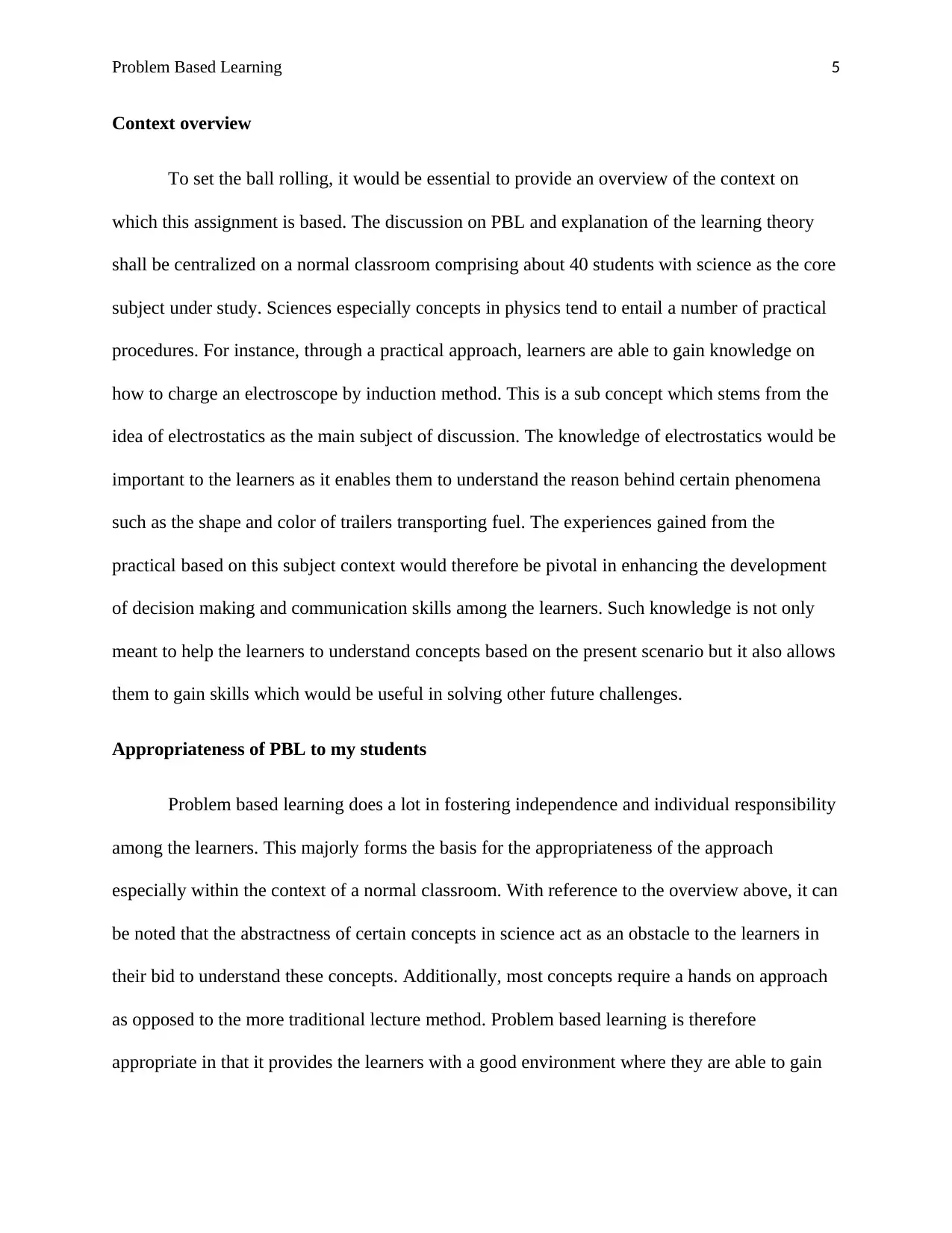
Problem Based Learning 5
Context overview
To set the ball rolling, it would be essential to provide an overview of the context on
which this assignment is based. The discussion on PBL and explanation of the learning theory
shall be centralized on a normal classroom comprising about 40 students with science as the core
subject under study. Sciences especially concepts in physics tend to entail a number of practical
procedures. For instance, through a practical approach, learners are able to gain knowledge on
how to charge an electroscope by induction method. This is a sub concept which stems from the
idea of electrostatics as the main subject of discussion. The knowledge of electrostatics would be
important to the learners as it enables them to understand the reason behind certain phenomena
such as the shape and color of trailers transporting fuel. The experiences gained from the
practical based on this subject context would therefore be pivotal in enhancing the development
of decision making and communication skills among the learners. Such knowledge is not only
meant to help the learners to understand concepts based on the present scenario but it also allows
them to gain skills which would be useful in solving other future challenges.
Appropriateness of PBL to my students
Problem based learning does a lot in fostering independence and individual responsibility
among the learners. This majorly forms the basis for the appropriateness of the approach
especially within the context of a normal classroom. With reference to the overview above, it can
be noted that the abstractness of certain concepts in science act as an obstacle to the learners in
their bid to understand these concepts. Additionally, most concepts require a hands on approach
as opposed to the more traditional lecture method. Problem based learning is therefore
appropriate in that it provides the learners with a good environment where they are able to gain
Context overview
To set the ball rolling, it would be essential to provide an overview of the context on
which this assignment is based. The discussion on PBL and explanation of the learning theory
shall be centralized on a normal classroom comprising about 40 students with science as the core
subject under study. Sciences especially concepts in physics tend to entail a number of practical
procedures. For instance, through a practical approach, learners are able to gain knowledge on
how to charge an electroscope by induction method. This is a sub concept which stems from the
idea of electrostatics as the main subject of discussion. The knowledge of electrostatics would be
important to the learners as it enables them to understand the reason behind certain phenomena
such as the shape and color of trailers transporting fuel. The experiences gained from the
practical based on this subject context would therefore be pivotal in enhancing the development
of decision making and communication skills among the learners. Such knowledge is not only
meant to help the learners to understand concepts based on the present scenario but it also allows
them to gain skills which would be useful in solving other future challenges.
Appropriateness of PBL to my students
Problem based learning does a lot in fostering independence and individual responsibility
among the learners. This majorly forms the basis for the appropriateness of the approach
especially within the context of a normal classroom. With reference to the overview above, it can
be noted that the abstractness of certain concepts in science act as an obstacle to the learners in
their bid to understand these concepts. Additionally, most concepts require a hands on approach
as opposed to the more traditional lecture method. Problem based learning is therefore
appropriate in that it provides the learners with a good environment where they are able to gain
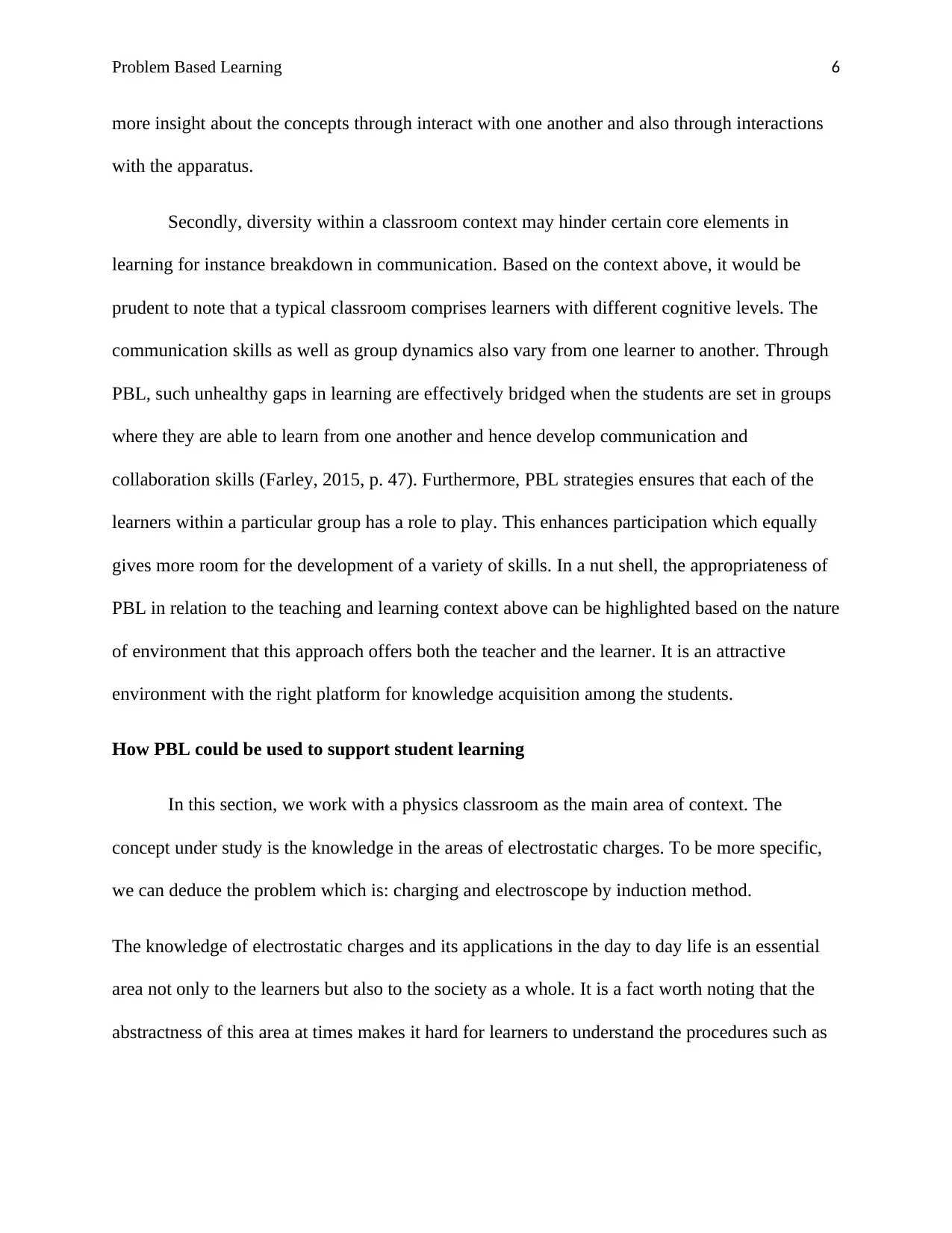
Problem Based Learning 6
more insight about the concepts through interact with one another and also through interactions
with the apparatus.
Secondly, diversity within a classroom context may hinder certain core elements in
learning for instance breakdown in communication. Based on the context above, it would be
prudent to note that a typical classroom comprises learners with different cognitive levels. The
communication skills as well as group dynamics also vary from one learner to another. Through
PBL, such unhealthy gaps in learning are effectively bridged when the students are set in groups
where they are able to learn from one another and hence develop communication and
collaboration skills (Farley, 2015, p. 47). Furthermore, PBL strategies ensures that each of the
learners within a particular group has a role to play. This enhances participation which equally
gives more room for the development of a variety of skills. In a nut shell, the appropriateness of
PBL in relation to the teaching and learning context above can be highlighted based on the nature
of environment that this approach offers both the teacher and the learner. It is an attractive
environment with the right platform for knowledge acquisition among the students.
How PBL could be used to support student learning
In this section, we work with a physics classroom as the main area of context. The
concept under study is the knowledge in the areas of electrostatic charges. To be more specific,
we can deduce the problem which is: charging and electroscope by induction method.
The knowledge of electrostatic charges and its applications in the day to day life is an essential
area not only to the learners but also to the society as a whole. It is a fact worth noting that the
abstractness of this area at times makes it hard for learners to understand the procedures such as
more insight about the concepts through interact with one another and also through interactions
with the apparatus.
Secondly, diversity within a classroom context may hinder certain core elements in
learning for instance breakdown in communication. Based on the context above, it would be
prudent to note that a typical classroom comprises learners with different cognitive levels. The
communication skills as well as group dynamics also vary from one learner to another. Through
PBL, such unhealthy gaps in learning are effectively bridged when the students are set in groups
where they are able to learn from one another and hence develop communication and
collaboration skills (Farley, 2015, p. 47). Furthermore, PBL strategies ensures that each of the
learners within a particular group has a role to play. This enhances participation which equally
gives more room for the development of a variety of skills. In a nut shell, the appropriateness of
PBL in relation to the teaching and learning context above can be highlighted based on the nature
of environment that this approach offers both the teacher and the learner. It is an attractive
environment with the right platform for knowledge acquisition among the students.
How PBL could be used to support student learning
In this section, we work with a physics classroom as the main area of context. The
concept under study is the knowledge in the areas of electrostatic charges. To be more specific,
we can deduce the problem which is: charging and electroscope by induction method.
The knowledge of electrostatic charges and its applications in the day to day life is an essential
area not only to the learners but also to the society as a whole. It is a fact worth noting that the
abstractness of this area at times makes it hard for learners to understand the procedures such as
⊘ This is a preview!⊘
Do you want full access?
Subscribe today to unlock all pages.

Trusted by 1+ million students worldwide
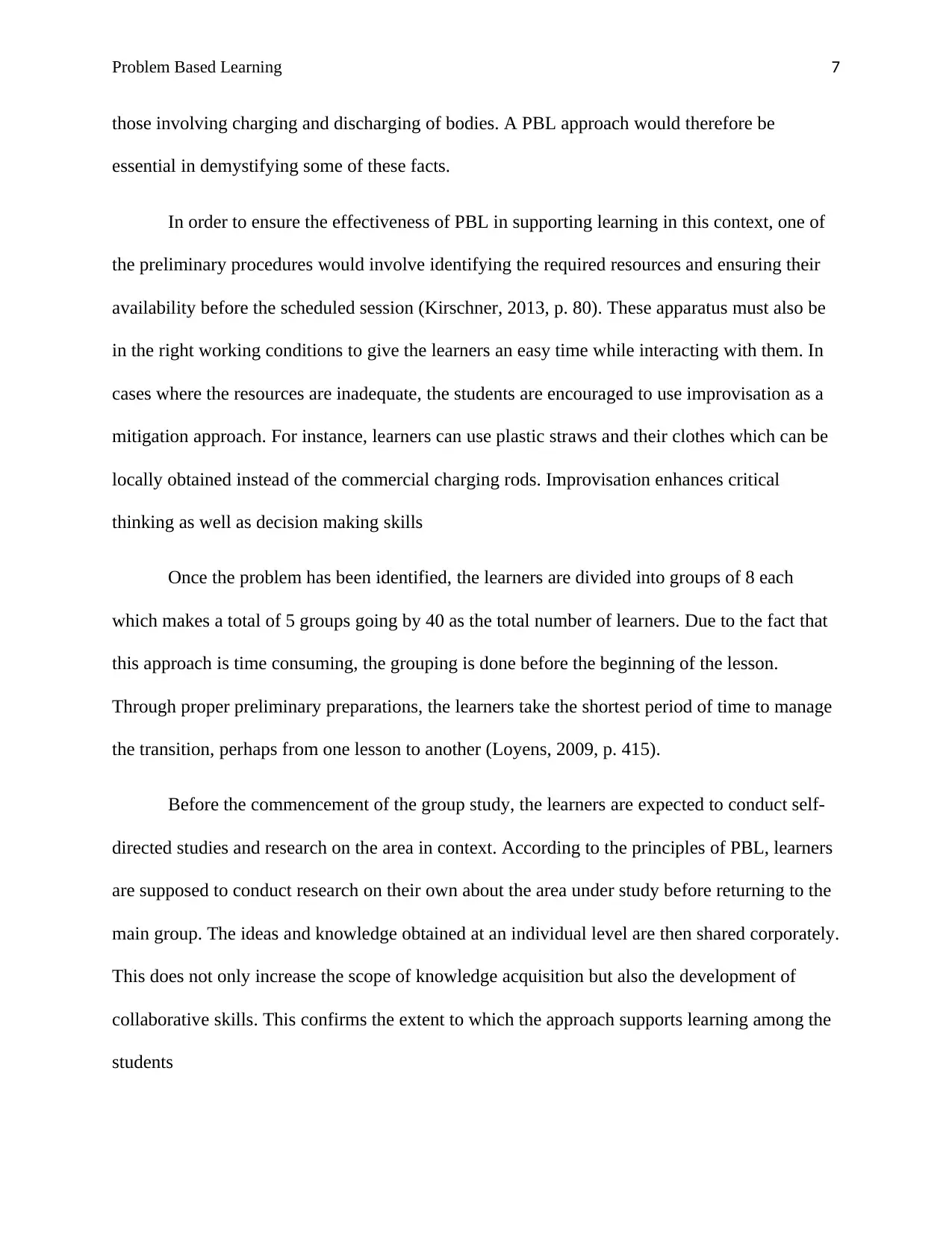
Problem Based Learning 7
those involving charging and discharging of bodies. A PBL approach would therefore be
essential in demystifying some of these facts.
In order to ensure the effectiveness of PBL in supporting learning in this context, one of
the preliminary procedures would involve identifying the required resources and ensuring their
availability before the scheduled session (Kirschner, 2013, p. 80). These apparatus must also be
in the right working conditions to give the learners an easy time while interacting with them. In
cases where the resources are inadequate, the students are encouraged to use improvisation as a
mitigation approach. For instance, learners can use plastic straws and their clothes which can be
locally obtained instead of the commercial charging rods. Improvisation enhances critical
thinking as well as decision making skills
Once the problem has been identified, the learners are divided into groups of 8 each
which makes a total of 5 groups going by 40 as the total number of learners. Due to the fact that
this approach is time consuming, the grouping is done before the beginning of the lesson.
Through proper preliminary preparations, the learners take the shortest period of time to manage
the transition, perhaps from one lesson to another (Loyens, 2009, p. 415).
Before the commencement of the group study, the learners are expected to conduct self-
directed studies and research on the area in context. According to the principles of PBL, learners
are supposed to conduct research on their own about the area under study before returning to the
main group. The ideas and knowledge obtained at an individual level are then shared corporately.
This does not only increase the scope of knowledge acquisition but also the development of
collaborative skills. This confirms the extent to which the approach supports learning among the
students
those involving charging and discharging of bodies. A PBL approach would therefore be
essential in demystifying some of these facts.
In order to ensure the effectiveness of PBL in supporting learning in this context, one of
the preliminary procedures would involve identifying the required resources and ensuring their
availability before the scheduled session (Kirschner, 2013, p. 80). These apparatus must also be
in the right working conditions to give the learners an easy time while interacting with them. In
cases where the resources are inadequate, the students are encouraged to use improvisation as a
mitigation approach. For instance, learners can use plastic straws and their clothes which can be
locally obtained instead of the commercial charging rods. Improvisation enhances critical
thinking as well as decision making skills
Once the problem has been identified, the learners are divided into groups of 8 each
which makes a total of 5 groups going by 40 as the total number of learners. Due to the fact that
this approach is time consuming, the grouping is done before the beginning of the lesson.
Through proper preliminary preparations, the learners take the shortest period of time to manage
the transition, perhaps from one lesson to another (Loyens, 2009, p. 415).
Before the commencement of the group study, the learners are expected to conduct self-
directed studies and research on the area in context. According to the principles of PBL, learners
are supposed to conduct research on their own about the area under study before returning to the
main group. The ideas and knowledge obtained at an individual level are then shared corporately.
This does not only increase the scope of knowledge acquisition but also the development of
collaborative skills. This confirms the extent to which the approach supports learning among the
students
Paraphrase This Document
Need a fresh take? Get an instant paraphrase of this document with our AI Paraphraser
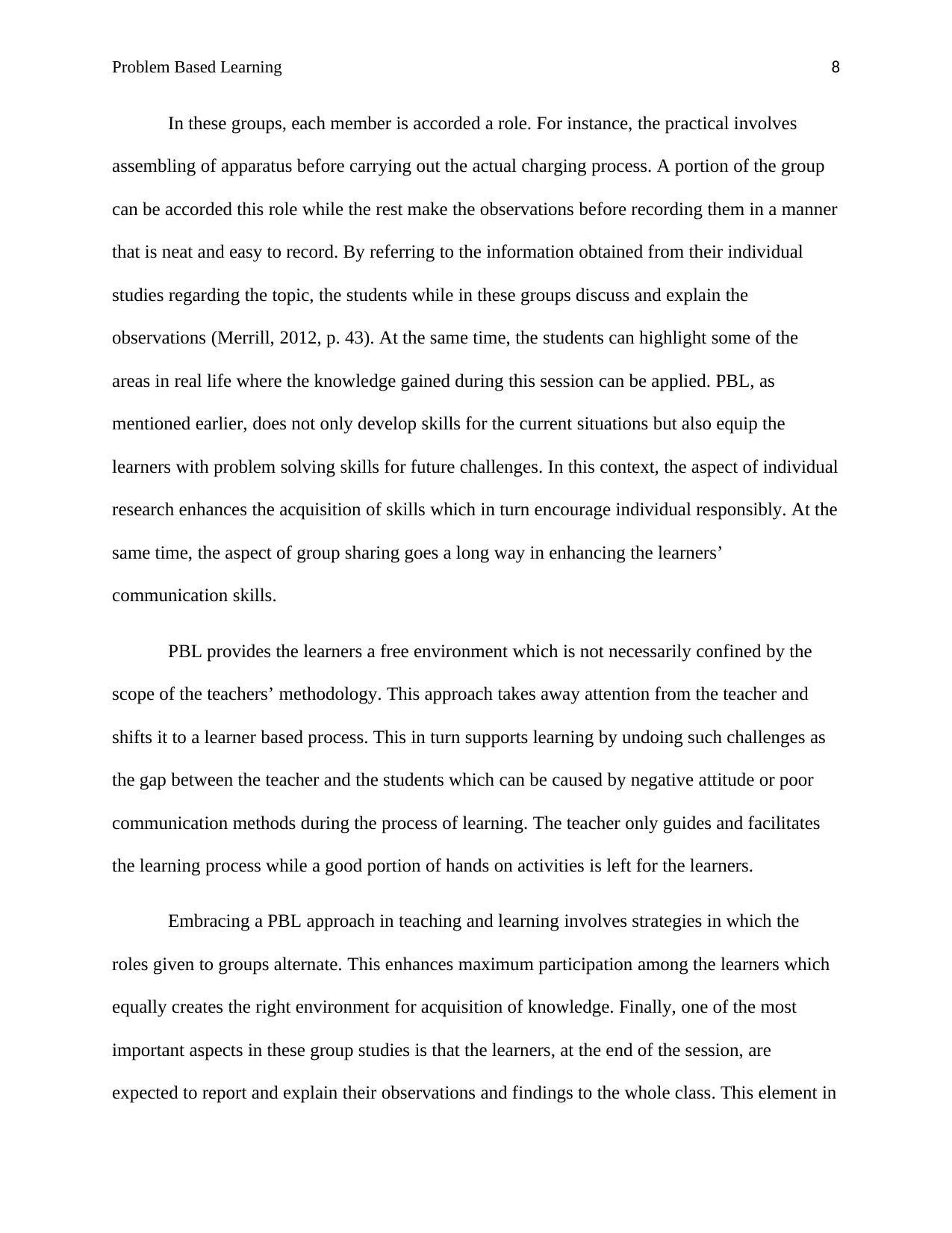
Problem Based Learning 8
In these groups, each member is accorded a role. For instance, the practical involves
assembling of apparatus before carrying out the actual charging process. A portion of the group
can be accorded this role while the rest make the observations before recording them in a manner
that is neat and easy to record. By referring to the information obtained from their individual
studies regarding the topic, the students while in these groups discuss and explain the
observations (Merrill, 2012, p. 43). At the same time, the students can highlight some of the
areas in real life where the knowledge gained during this session can be applied. PBL, as
mentioned earlier, does not only develop skills for the current situations but also equip the
learners with problem solving skills for future challenges. In this context, the aspect of individual
research enhances the acquisition of skills which in turn encourage individual responsibly. At the
same time, the aspect of group sharing goes a long way in enhancing the learners’
communication skills.
PBL provides the learners a free environment which is not necessarily confined by the
scope of the teachers’ methodology. This approach takes away attention from the teacher and
shifts it to a learner based process. This in turn supports learning by undoing such challenges as
the gap between the teacher and the students which can be caused by negative attitude or poor
communication methods during the process of learning. The teacher only guides and facilitates
the learning process while a good portion of hands on activities is left for the learners.
Embracing a PBL approach in teaching and learning involves strategies in which the
roles given to groups alternate. This enhances maximum participation among the learners which
equally creates the right environment for acquisition of knowledge. Finally, one of the most
important aspects in these group studies is that the learners, at the end of the session, are
expected to report and explain their observations and findings to the whole class. This element in
In these groups, each member is accorded a role. For instance, the practical involves
assembling of apparatus before carrying out the actual charging process. A portion of the group
can be accorded this role while the rest make the observations before recording them in a manner
that is neat and easy to record. By referring to the information obtained from their individual
studies regarding the topic, the students while in these groups discuss and explain the
observations (Merrill, 2012, p. 43). At the same time, the students can highlight some of the
areas in real life where the knowledge gained during this session can be applied. PBL, as
mentioned earlier, does not only develop skills for the current situations but also equip the
learners with problem solving skills for future challenges. In this context, the aspect of individual
research enhances the acquisition of skills which in turn encourage individual responsibly. At the
same time, the aspect of group sharing goes a long way in enhancing the learners’
communication skills.
PBL provides the learners a free environment which is not necessarily confined by the
scope of the teachers’ methodology. This approach takes away attention from the teacher and
shifts it to a learner based process. This in turn supports learning by undoing such challenges as
the gap between the teacher and the students which can be caused by negative attitude or poor
communication methods during the process of learning. The teacher only guides and facilitates
the learning process while a good portion of hands on activities is left for the learners.
Embracing a PBL approach in teaching and learning involves strategies in which the
roles given to groups alternate. This enhances maximum participation among the learners which
equally creates the right environment for acquisition of knowledge. Finally, one of the most
important aspects in these group studies is that the learners, at the end of the session, are
expected to report and explain their observations and findings to the whole class. This element in
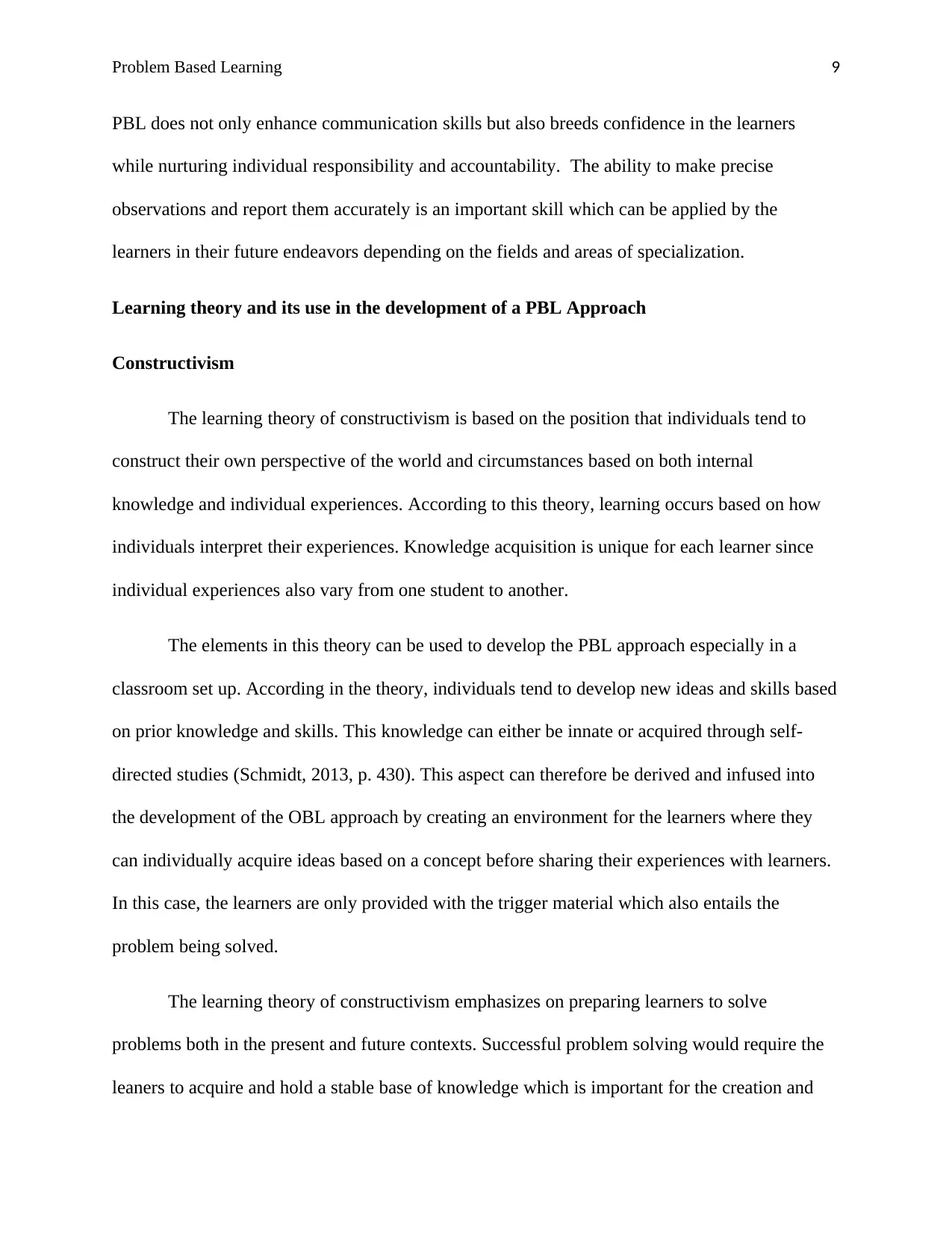
Problem Based Learning 9
PBL does not only enhance communication skills but also breeds confidence in the learners
while nurturing individual responsibility and accountability. The ability to make precise
observations and report them accurately is an important skill which can be applied by the
learners in their future endeavors depending on the fields and areas of specialization.
Learning theory and its use in the development of a PBL Approach
Constructivism
The learning theory of constructivism is based on the position that individuals tend to
construct their own perspective of the world and circumstances based on both internal
knowledge and individual experiences. According to this theory, learning occurs based on how
individuals interpret their experiences. Knowledge acquisition is unique for each learner since
individual experiences also vary from one student to another.
The elements in this theory can be used to develop the PBL approach especially in a
classroom set up. According in the theory, individuals tend to develop new ideas and skills based
on prior knowledge and skills. This knowledge can either be innate or acquired through self-
directed studies (Schmidt, 2013, p. 430). This aspect can therefore be derived and infused into
the development of the OBL approach by creating an environment for the learners where they
can individually acquire ideas based on a concept before sharing their experiences with learners.
In this case, the learners are only provided with the trigger material which also entails the
problem being solved.
The learning theory of constructivism emphasizes on preparing learners to solve
problems both in the present and future contexts. Successful problem solving would require the
leaners to acquire and hold a stable base of knowledge which is important for the creation and
PBL does not only enhance communication skills but also breeds confidence in the learners
while nurturing individual responsibility and accountability. The ability to make precise
observations and report them accurately is an important skill which can be applied by the
learners in their future endeavors depending on the fields and areas of specialization.
Learning theory and its use in the development of a PBL Approach
Constructivism
The learning theory of constructivism is based on the position that individuals tend to
construct their own perspective of the world and circumstances based on both internal
knowledge and individual experiences. According to this theory, learning occurs based on how
individuals interpret their experiences. Knowledge acquisition is unique for each learner since
individual experiences also vary from one student to another.
The elements in this theory can be used to develop the PBL approach especially in a
classroom set up. According in the theory, individuals tend to develop new ideas and skills based
on prior knowledge and skills. This knowledge can either be innate or acquired through self-
directed studies (Schmidt, 2013, p. 430). This aspect can therefore be derived and infused into
the development of the OBL approach by creating an environment for the learners where they
can individually acquire ideas based on a concept before sharing their experiences with learners.
In this case, the learners are only provided with the trigger material which also entails the
problem being solved.
The learning theory of constructivism emphasizes on preparing learners to solve
problems both in the present and future contexts. Successful problem solving would require the
leaners to acquire and hold a stable base of knowledge which is important for the creation and
⊘ This is a preview!⊘
Do you want full access?
Subscribe today to unlock all pages.

Trusted by 1+ million students worldwide
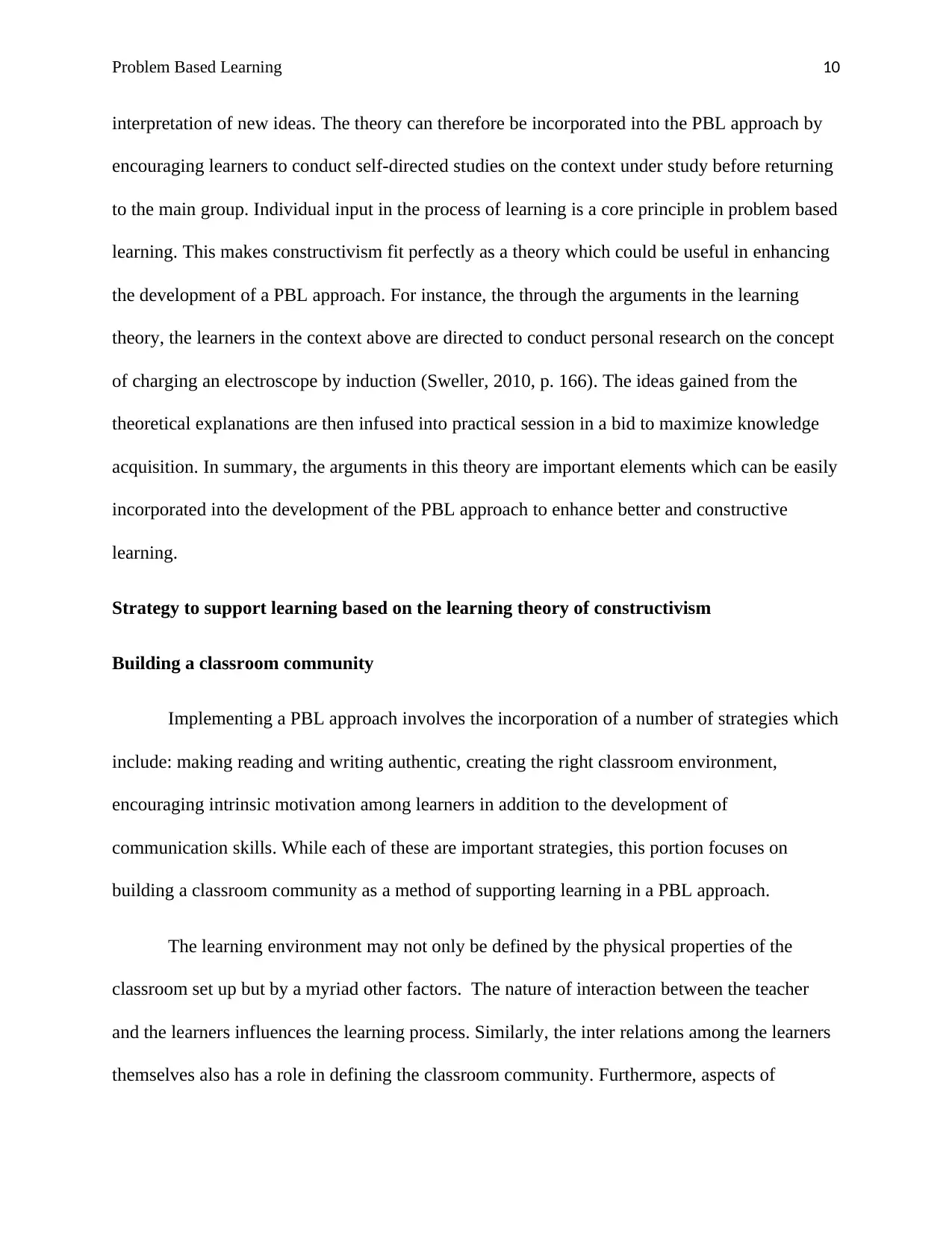
Problem Based Learning 10
interpretation of new ideas. The theory can therefore be incorporated into the PBL approach by
encouraging learners to conduct self-directed studies on the context under study before returning
to the main group. Individual input in the process of learning is a core principle in problem based
learning. This makes constructivism fit perfectly as a theory which could be useful in enhancing
the development of a PBL approach. For instance, the through the arguments in the learning
theory, the learners in the context above are directed to conduct personal research on the concept
of charging an electroscope by induction (Sweller, 2010, p. 166). The ideas gained from the
theoretical explanations are then infused into practical session in a bid to maximize knowledge
acquisition. In summary, the arguments in this theory are important elements which can be easily
incorporated into the development of the PBL approach to enhance better and constructive
learning.
Strategy to support learning based on the learning theory of constructivism
Building a classroom community
Implementing a PBL approach involves the incorporation of a number of strategies which
include: making reading and writing authentic, creating the right classroom environment,
encouraging intrinsic motivation among learners in addition to the development of
communication skills. While each of these are important strategies, this portion focuses on
building a classroom community as a method of supporting learning in a PBL approach.
The learning environment may not only be defined by the physical properties of the
classroom set up but by a myriad other factors. The nature of interaction between the teacher
and the learners influences the learning process. Similarly, the inter relations among the learners
themselves also has a role in defining the classroom community. Furthermore, aspects of
interpretation of new ideas. The theory can therefore be incorporated into the PBL approach by
encouraging learners to conduct self-directed studies on the context under study before returning
to the main group. Individual input in the process of learning is a core principle in problem based
learning. This makes constructivism fit perfectly as a theory which could be useful in enhancing
the development of a PBL approach. For instance, the through the arguments in the learning
theory, the learners in the context above are directed to conduct personal research on the concept
of charging an electroscope by induction (Sweller, 2010, p. 166). The ideas gained from the
theoretical explanations are then infused into practical session in a bid to maximize knowledge
acquisition. In summary, the arguments in this theory are important elements which can be easily
incorporated into the development of the PBL approach to enhance better and constructive
learning.
Strategy to support learning based on the learning theory of constructivism
Building a classroom community
Implementing a PBL approach involves the incorporation of a number of strategies which
include: making reading and writing authentic, creating the right classroom environment,
encouraging intrinsic motivation among learners in addition to the development of
communication skills. While each of these are important strategies, this portion focuses on
building a classroom community as a method of supporting learning in a PBL approach.
The learning environment may not only be defined by the physical properties of the
classroom set up but by a myriad other factors. The nature of interaction between the teacher
and the learners influences the learning process. Similarly, the inter relations among the learners
themselves also has a role in defining the classroom community. Furthermore, aspects of
Paraphrase This Document
Need a fresh take? Get an instant paraphrase of this document with our AI Paraphraser
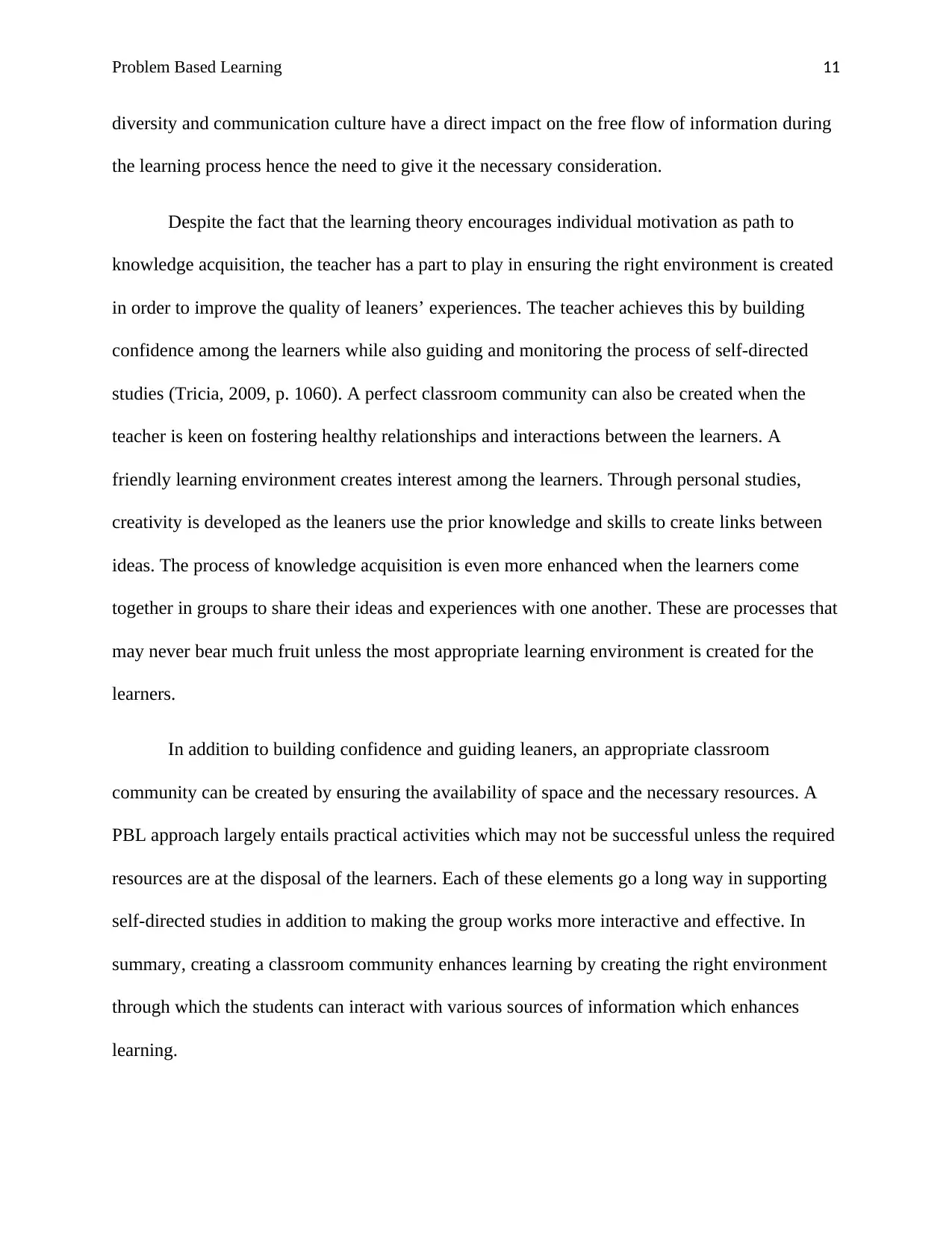
Problem Based Learning 11
diversity and communication culture have a direct impact on the free flow of information during
the learning process hence the need to give it the necessary consideration.
Despite the fact that the learning theory encourages individual motivation as path to
knowledge acquisition, the teacher has a part to play in ensuring the right environment is created
in order to improve the quality of leaners’ experiences. The teacher achieves this by building
confidence among the learners while also guiding and monitoring the process of self-directed
studies (Tricia, 2009, p. 1060). A perfect classroom community can also be created when the
teacher is keen on fostering healthy relationships and interactions between the learners. A
friendly learning environment creates interest among the learners. Through personal studies,
creativity is developed as the leaners use the prior knowledge and skills to create links between
ideas. The process of knowledge acquisition is even more enhanced when the learners come
together in groups to share their ideas and experiences with one another. These are processes that
may never bear much fruit unless the most appropriate learning environment is created for the
learners.
In addition to building confidence and guiding leaners, an appropriate classroom
community can be created by ensuring the availability of space and the necessary resources. A
PBL approach largely entails practical activities which may not be successful unless the required
resources are at the disposal of the learners. Each of these elements go a long way in supporting
self-directed studies in addition to making the group works more interactive and effective. In
summary, creating a classroom community enhances learning by creating the right environment
through which the students can interact with various sources of information which enhances
learning.
diversity and communication culture have a direct impact on the free flow of information during
the learning process hence the need to give it the necessary consideration.
Despite the fact that the learning theory encourages individual motivation as path to
knowledge acquisition, the teacher has a part to play in ensuring the right environment is created
in order to improve the quality of leaners’ experiences. The teacher achieves this by building
confidence among the learners while also guiding and monitoring the process of self-directed
studies (Tricia, 2009, p. 1060). A perfect classroom community can also be created when the
teacher is keen on fostering healthy relationships and interactions between the learners. A
friendly learning environment creates interest among the learners. Through personal studies,
creativity is developed as the leaners use the prior knowledge and skills to create links between
ideas. The process of knowledge acquisition is even more enhanced when the learners come
together in groups to share their ideas and experiences with one another. These are processes that
may never bear much fruit unless the most appropriate learning environment is created for the
learners.
In addition to building confidence and guiding leaners, an appropriate classroom
community can be created by ensuring the availability of space and the necessary resources. A
PBL approach largely entails practical activities which may not be successful unless the required
resources are at the disposal of the learners. Each of these elements go a long way in supporting
self-directed studies in addition to making the group works more interactive and effective. In
summary, creating a classroom community enhances learning by creating the right environment
through which the students can interact with various sources of information which enhances
learning.
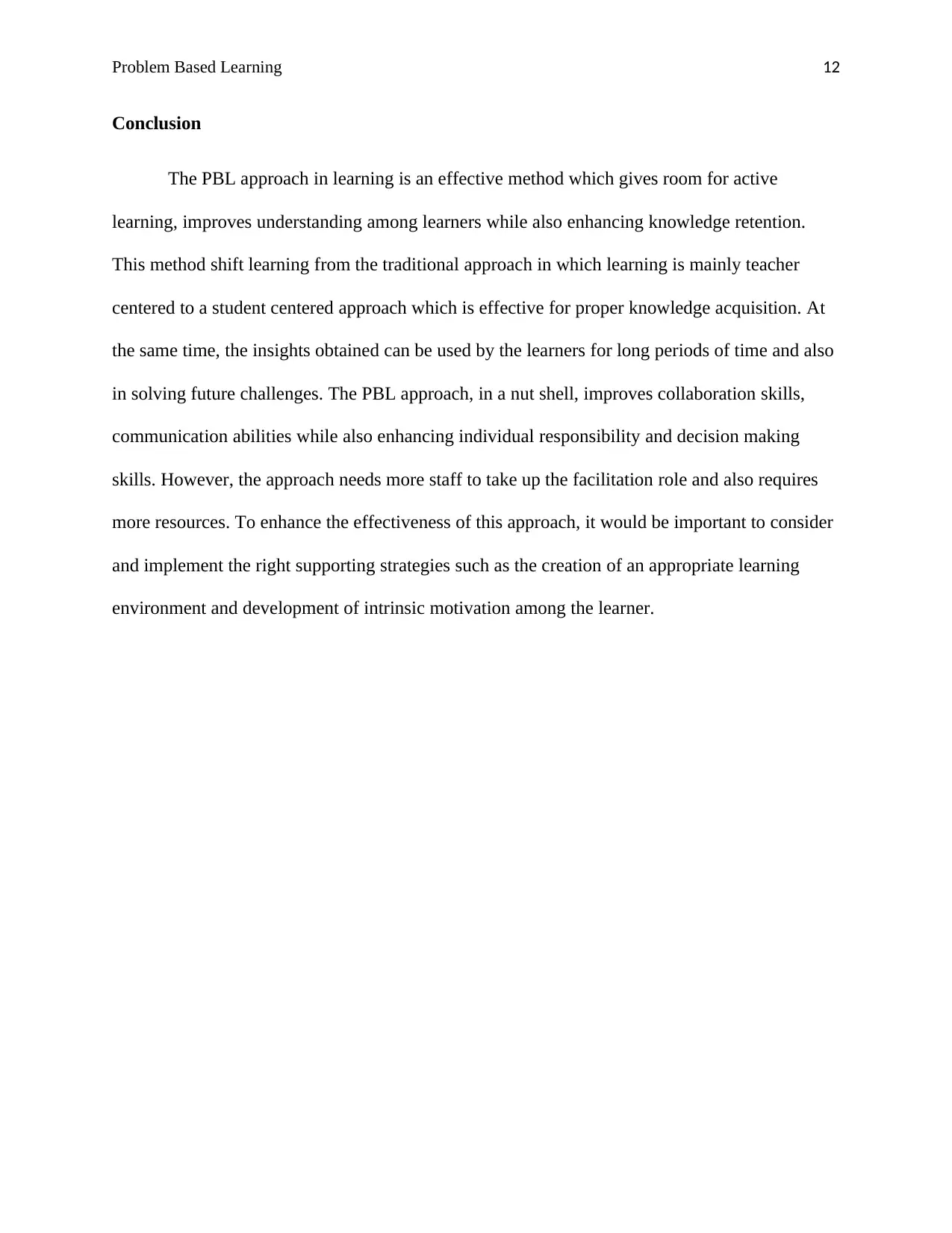
Problem Based Learning 12
Conclusion
The PBL approach in learning is an effective method which gives room for active
learning, improves understanding among learners while also enhancing knowledge retention.
This method shift learning from the traditional approach in which learning is mainly teacher
centered to a student centered approach which is effective for proper knowledge acquisition. At
the same time, the insights obtained can be used by the learners for long periods of time and also
in solving future challenges. The PBL approach, in a nut shell, improves collaboration skills,
communication abilities while also enhancing individual responsibility and decision making
skills. However, the approach needs more staff to take up the facilitation role and also requires
more resources. To enhance the effectiveness of this approach, it would be important to consider
and implement the right supporting strategies such as the creation of an appropriate learning
environment and development of intrinsic motivation among the learner.
Conclusion
The PBL approach in learning is an effective method which gives room for active
learning, improves understanding among learners while also enhancing knowledge retention.
This method shift learning from the traditional approach in which learning is mainly teacher
centered to a student centered approach which is effective for proper knowledge acquisition. At
the same time, the insights obtained can be used by the learners for long periods of time and also
in solving future challenges. The PBL approach, in a nut shell, improves collaboration skills,
communication abilities while also enhancing individual responsibility and decision making
skills. However, the approach needs more staff to take up the facilitation role and also requires
more resources. To enhance the effectiveness of this approach, it would be important to consider
and implement the right supporting strategies such as the creation of an appropriate learning
environment and development of intrinsic motivation among the learner.
⊘ This is a preview!⊘
Do you want full access?
Subscribe today to unlock all pages.

Trusted by 1+ million students worldwide
1 out of 14
Related Documents
Your All-in-One AI-Powered Toolkit for Academic Success.
+13062052269
info@desklib.com
Available 24*7 on WhatsApp / Email
![[object Object]](/_next/static/media/star-bottom.7253800d.svg)
Unlock your academic potential
Copyright © 2020–2025 A2Z Services. All Rights Reserved. Developed and managed by ZUCOL.




